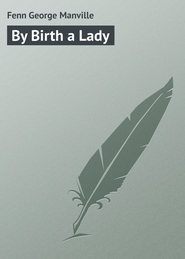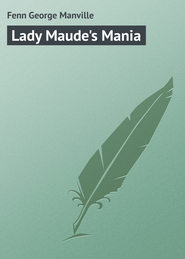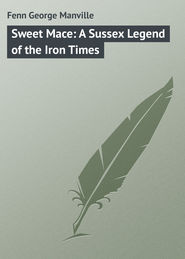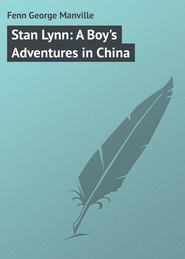По всем вопросам обращайтесь на: info@litportal.ru
(©) 2003-2025.
✖
George Alfred Henty: The Story of an Active Life
Настройки чтения
Размер шрифта
Высота строк
Поля
Henty says he remonstrated with a market woman, of whom he was willing to buy a bunch of grapes, when she held it out to him with eight or ten bees upon it, busily extracting honey, whereupon she laughed at him, picked the insects off with her fingers, and held them out to him to show that they were not disposed to use their stings even when roughly handled. An interesting fact this in natural history, and one which Henty admired, though he preferred seeing it done with other fingers than his own, and was quite content that the woman should have a poor opinion of his personal courage. But there are bees and bees, some more aggressive than others.
We all know the qualities of our own native bee, and any bee-keeper, unless he has been stung frequently and become inured, will tell you that the bees imported of late years from Liguria, and now acclimatised, have a rather vicious disposition.
These from the neighbourhood of Adelsberg are in all probability the reverse in character. Certainly they seem to vary, for Henty describes the honey as by no means good, being very dark-coloured, and having a strong, unpleasant twang. On the other hand, the flavour depends upon the neighbouring growth of flowers, and the taste may be given by some nectary common to the neighbourhood, possibly by what Henty describes when he says the fields were bright with purple crocus, which he had never before seen flowering at this time of year – October – evidently a mistake on his part, for the colchicum, the producer of the old-world remedy for gout.
Chapter Twelve.
A Subterranean Excursion
The next day Henty started for his eagerly anticipated plunge into the far-famed Grotto of Adelsberg, and he frankly declares at once that there are some sights of which it is impossible by mere words to convey any adequate impression, and to do justice to which it would be necessary to combine the epithets and imagery of a dozen languages.
“Foremost among these,” he says, “is the Grotto of Adelsberg, and I had hardly entered it when I became painfully conscious that the idea with which I had come – namely, of writing a description which should give a vivid conception of the most beautiful and varied succession of grottoes in the world – was hopelessly beyond my powers.”
The entrance to the caverns is about a mile from Adelsberg, and a little way up the side of a limestone mountain whose strata dip at an angle of about forty-five degrees. Immediately below the entrance a good-sized stream plunges into a low cavern and reappears only some ten miles distant in a direct line to the north. But some idea of the actual course of this river may be gained from the fact that pieces of cork thrown in where the river disappears do not emerge again for twelve hours, which goes to prove that the distance they have travelled is more than double the above. There are, it seems, two entrances, and in the one followed, the path at first led through a passage or corridor of no great length, and then opened suddenly into a noble cavern known as the “Dome.”
This was all that was known of the grottoes till the year 1819, when a workman accidentally destroyed a stalactite screen and discovered the entrance to the apparently illimitable series of caves beyond. Of these, five miles in length have been explored; but the end has not been reached, and they extend for unknown distances in several directions. The effect of the Dome is superlatively grand. It is three hundred feet in length and one hundred feet in height and width. The sides are quite perpendicular, and at about half their height a natural gallery runs partially round them. The view from this is magnificent in the extreme. The guides who accompanied the visitors placed candles at short intervals along the parapet, but their light barely pierced the gloomy expanse. Upward the roof loomed dark and vague. Beneath, the river, which had commenced its subterranean passage, rushed brawling among rocks, and was crossed by a wooden bridge lit up by two rows of candles, whose rays were reflected in broken flashes from the black tumbling water.
At the extreme end of this vast hall a faint blue light showed where the daylight beyond struggled in at the outlet of the river cave. Above and around the roar of the stream was re-echoed and answered by a thousand low reverberating murmurs. The whole effect was ineffably solemn and awe-inspiring. Henty and his companions having provided themselves with magnesium wire at Trieste, this was now used, and the effect was absolutely startling. The light streamed out into the most distant recesses, the candles faded to dim red points, and the roof, which had before appeared of fabulous height, seemed now to be crushing down upon them, the stalactites of its rugged surface standing out clear and well defined. Then, as the bright white light with its clouding smoke died out, the darkness deepened with oppressive heaviness. Everything had been so grand, that it needed all the persuasions of the guide, who assured the party that far more beautiful things were to be seen beyond, before they could be induced to leave this spot and to ascend the steps which led to the entrance of the inner caves.
The path which they followed then was upwards of three miles long, and so arranged that they returned by a different series of grottoes from those they had traversed. The variety of scenery displayed in these three miles was extraordinary. Sometimes the way contracted into low narrow passages, at others opened out into enormous halls. Chambers and corridors, fairy grottoes and gloomy caves, alternated with each other, and the principal halls were popularly named the Ball-room, the Concert-room, and the Calvary. The Ball-room was of nearly the same proportions as the Dome, except that the height was not so great, but its character was entirely different. It was graceful and airy, and was apparently illuminated with numerous chandeliers. The floor was perfectly smooth and level, and at one end an artificial orchestra had been erected in the midst of a group of crags and stalagmites. This, once a year, is really used as a ball-room for a dance, to which thousands of the surrounding peasantry flock. Nothing could be more beautiful than the way in which the walls are decked by nature. Everywhere from walls and roof depend masses of stalactites of the most graceful and elegant forms. Floating draperies are festooned around. Filmy, semi-transparent veils seem to wave gently to and fro as they sparkle in the numerous lights. Here appear drooping pendants and tapering spike-like projections; there, majestic pillars and clustering columns.
The Concert-room is similar in character, but larger and narrower, and hence issued an immense and gloomy corridor more than a hundred feet high. The floor was covered with masses of loose rock, whose huge and rugged shapes loomed, distorted and uncouth, in the faint light of the candles.
From this abode of gloom they entered the Calvary, which appeared to be the largest of all the halls. It must have been three hundred feet long and upwards of two hundred wide. At one end rose a lofty heap of rocks that had fallen from the roof and been cemented together by stalagmites. It bore a resemblance to a great shrine, and was brilliantly illuminated, while the rest of the vast space lay in deep and mysterious shadow. From the lower end, where the observers stood, the floor sloped steeply up. It was composed of misshapen blocks of stone, for at some far-distant period the whole interior, now a flat bare surface, must have fallen with a mighty crash, brought down by the weight of the stalactites that had formed upon it. That the catastrophe happened long ages since was evidenced by the fact that the whole floor was covered with stalagmites of various sizes and heights, which looked as though a forest of great pines had once grown there, till their trunks had been snapped short off by the swoop of some mighty whirlwind.
There was a weird grandeur about this hall which was almost appalling, producing as it did questioning fancies respecting the possibility of a repetition of the old-world scene.
In the corridors and caves that intervened between these principal chambers and halls there was an infinity of fantastic shapes, in which fancy could trace almost every known form. A monstrous bee-hive, a Brobdingnagian tortoise, huge fallen trees covered with lichens growing rankly, half-rounded nodules, and great wart-like protuberances. In one place the roof would be supported by Gothic columns, farther on by unshapely props and buttresses. In one corner rough stems as of ivy seemed to be clinging to the wall, or the gnarled trunks of oaks thrust themselves up between the blocks. Above one cave it seemed as if a great tree were growing, whose twining roots hung down from the roof.
And so on, and so on, fancy helping the visitor to believe that he was gazing upon long ranges of organ pipes, upon stems of palm-trees with well-defined marks whence the broad leaves had sprouted, or upon basaltic columns, with wide steps slowly formed by ages, where water had trickled down. Farther on, too, at intervals, creamy-red couches seemed to be temptingly placed, with folds of a soft white material thrown carelessly over them, while long flags and fringed draperies of admirable texture and design drooped down from chinks and crannies in the roof, as if to form decorations for some fête in the world of the gnomes.
There was no end to the wonders wrought by nature’s own sculptors – fonts, chalices, exquisitely chased imaged shrines, and strange confessionals; groups of statuary wrought in beauty, with roofs above covered with fretwork of the most delicate tracery; and in opposition there was the grotesque on every hand, with squat heathen idols, grim corbels, and in the darkness, with Doré-like effect, diabolical-looking creations or works as of some enchanter’s wand. In parts everything was so real, that it was impossible not to believe that that cascade, glistening as it did when the lights were turned upon it, was not deep water, but only stone, or that a fountain glittering with diamond spray in the passing light was not composed of liquid drops.
In one cave the wall seemed to be hung in ruddy masses of stalactite of so truly a fleshy tint that they seemed to be palpably strips of flesh, which carried the spectator back to old classic readings and the legends of the Latin ancients. For it seemed as if the cave might be the spot where Apollo had skinned Marsyas, and Henty listened as if expectant of hearing the sufferer’s howls re-echo through the vast labyrinth. For here seemed to hang his flesh – great strips of muscle and tendon, some looking cold and stiff, others soft and limp, with the glowing tint of life still warm upon them. It was terribly real.
Earthy solutions had stained some of the stalactites of a dirty grey hue, the material of the carbonate of lime being dull and coarse; but others again were white as alabaster, the carbonate giving place to the sulphate, and looking pure and semi-transparent. In many places the surface of the deposit of lime, slowly formed of nature’s great patience, was smooth as polished marble, while in other places, suggestive of the more ready work of heated springs of water charged with lime, the deposit was uneven as masses of coral. The tints, too, varied from clear white to cream colour, orange, and red; and while in many places the drooping stalactites were dull and soft-looking, and reflected no light, in others they sparkled with myriads of coruscations as of diamonds, emeralds, and rubies; or rather, as they changed and flashed in the passing light, they resembled rocks over which a thin film of jewels was streaming, or a sudden blaze of sunshine upon hoar frost.
And it was not only the eye that was dazzled and seemed to gather an imagination of its own; but there were wonders for the ear, for now and again there were hanging masses offering themselves to be struck, waiting there in the whispering silence of the vast halls of wonder, to give out a clear bell-like sound which varied from the sharp ring of a struck glass to the deep soft boom of some cathedral bell, the tone being invariably much purer and sweeter from the semi-transparent blocks than from those that were formed of material which was loose and coarse.
Many of the caves that closely adjoined each other varied in the most extraordinary manner. Some seemed to be dark and murky, suitable homes for gnomes and evil genii. Misshapen monsters appeared to lurk, eerie and gruesome, in obscure corners; slimy and uncouth reptiles seemed to crawl and grovel in the damp mire, looking horribly real, though only fancy save in the solidity of stone.
And then, gloomily seen on high, weird, shadowy creatures, dank and bat-like with their dusky wings, appeared to be hovering just beneath the roof, till a nameless horror seemed to pervade the gloomy atmosphere, and the imagination peopled the place with unearthly creatures which the mind refused to believe were illusory, so real were they in their stony extravagance; yet all were the work of nature, formed through the dark ages slowly, drop by drop.
There they were in the dim nooks and recesses, seeming, as the smoking candles flickered upon their glistening surfaces, to beckon and grin, peering round twisted buttresses, gloating, vampire-like, on the passer-by from behind the fallen columns, and producing a shuddering horror, as they seemed to be only waiting till the visitors to these awful shades had passed before they sprang.
It was here that even the brilliant rays of magnesium failed to dispel the gathered blackness, and the strange shapes stood out more spectral and awe-inspiring than before. And it was water – water everywhere, drip, drip, drip, never ceasing – the hardest of hard water, that the most thirsty in these caverns would shrink from drinking, for he would know that he was sipping liquid stone, the stone that had built up everything around, and which would go on almost silently building fresh wonders until Time should be no more. And in spite of the flash and brilliancy of beauty as opposed to the dull, glistening, slimy look of much of nature’s work, there was something shuddering in its inspiration as he who gazed at the same time had what was going on conveyed to him through his ears – the drip of water never ceasing, and its feeble echoes seeming to rustle with mysterious whisper throughout these shadowy cells and proclaim the wonder-work in process of construction.
It was with a strange feeling of relief that they passed on out of these awe-inspiring caverns into a region where, in delightful contrast, the eyes were welcomed with a sight of what could only be the dwelling-places of the inhabitants of a kind of fairyland. Here all was graceful pinnacle, delicate spire, tapering point, and slender pillar, each frosted alike with silvery rime, which made the finger shrink when touching them; for it seemed, according to everyday knowledge, quite startling that these beautiful works of nature should feel cool and temperate; the visitor felt that they ought to sting the nerves with pain, for their sparkling effect looked so exactly as though it had been produced by frost.
Icy, too, appeared much of the beauty now – the sparkling fairy couches spread with frosty lace, the gauzy floating folds encrusted with gems. Everywhere the lights flashed and glittered, refracted in a thousand colours; for here, too, seemed to be the caves of crystal-land, the homes of the water sprites who dwelt where water had now become pure, solid, and perfect for evermore, where water had become pure ice that was not cold, where even the floor was white sparkling sand scattered with gleaming shells, above which the water fays floated, and the sea sprites played and chased fish in the ice grottoes.
Such were some of George Henty’s impressions of the Grotto of Adelsberg, and he concludes by saying that any traveller who has ever had the opportunity of seeing that home of nature’s wonders lit up as he had, would surely bear him out in saying that, so far from exaggerating, he has but touched upon a few of the varied and extraordinary beauties of the place.
Chapter Thirteen.
Mining for Mercury
Still feeling his great interest in mining to an extent that makes one wonder that he did not make that pursuit the work of his life to the same extent as he made yachting the pleasure, Henty now made his way to Idria to make a careful examination of the quicksilver mines, the property of the Austrian government. The journey was undertaken partly from its being likely to form an interesting letter, but still more probably from a desire to foster his own inclinations. And no wonder! For it is not every man who could write in perfect sincerity, “My experience of mines is very extensive,” and then go on to talk like a past master of mining in general, not in support of this assertion, but in proof of his general knowledge.
Reaching the quicksilver mines, which are, as is probably known, very few and far between upon the face of the earth, he gives a thorough description of the place. The workmen, he tells us, number some six hundred, the buildings connected with the mine are good and well kept, the posts and doors painted the familiar black and yellow of Austria, while the imperial arms, surmounted by the two crossed hammers, are fixed to the various offices.
In old works accounts are given about condemnation to the quicksilver mines and the convict life of the unfortunates, but Henty’s account of the place seems to prove everything to be very businesslike and matter-of-fact, and the old descriptions that blackened the administration would appear to have been extremely highly coloured. The government has erected a theatre for the use of the workmen, and has in other ways laid itself out to study their comforts in a manner for which its habitual detractors would hardly have given it credit.
The pay of the miners is about eightpence a day, apparently a very small sum, but which is above the average gain in a country where the necessaries of life are extremely cheap. When they are ill, and this is not infrequently the case, for the fumes of mercury are extremely deleterious, they receive three-quarter pay, together with medicine and medical attendance, while they are provided for in old age.
After this brief socio-political statement, the businesslike miner and student of geology speaks of the formation of the country where the mines are situated. This is an oolite limestone, that is to say, the cream-coloured soft building stone so familiar in building, which hardens in time, and is generally dubbed Bath-stone.
He was rather surprised that a quicksilver mine should be here, and he made a careful examination of the surface of the neighbourhood before descending, but could discover no signs of the existence of a mineral vein, and so felt at a loss to imagine what induced the original investigators to set to work at that particular spot.
Here is his version of the old story which credits the discovery of quicksilver as being due to a barrel-maker who, after making a tub, placed it under a dropping spring to see if it would hold water. When he came to look at it again, he found it contained what he took to be a certain amount of glistening water; but on attempting to move the tub, he discovered it to be so heavy that he could not lift it, the supposed water being the enormously heavy liquid, quicksilver.
Henty also relates that a spring that arose in Idria had been observed to deposit in the hollows of the stone small quantities of quicksilver. This came to the notice of a merchant from Trieste, who happened to be stopping in the neighbourhood. Being a business man whose head was screwed on the right way, he came to the conclusion that this quicksilver must issue from the rock in company with water, and that if he sank to a sufficient depth, the source from which the spring drew the mercury would be discovered. Without any delay he obtained a grant from government, began to sink, and carried on quicksilver-mining for some years with success. But it soon became evident to him that the primary source of the fluent metal was much deeper down, and to reach it much larger capital was required than he could command; so, still acting as the business man, he sold his works to the government, no doubt at an excellent profit, and by the government they have been carried on ever since. They are now the richest and most extensive of any in Europe, with the exception only of those at Almaden, in Spain.
Henty’s stay in Idria was only short; but being furnished with a guide, and having put on the suit of miner’s clothes provided for visitors, he commenced his descent. This was made by means of a number of inclined shafts of admirable masonry, worked in a perfect oval, and about seven feet in height. These can be best conceived by imagining a perfectly dry London sewer being placed nearly on end. In these shafts small stone steps were formed, by which the descent was made without fatigue or difficulty. He considered that these shafts were superior, both in arrangement and workmanship, to anything he had ever seen in his great experience.
On descending he noticed that the mine was worked, to speak technically, in five levels, and that in some places the quicksilver was in the familiar glistening globules in a soft and partially decomposed state. But the greater portion occurred in the aforesaid limestone itself, and even where it was present in the enormous proportion of eighty per cent it was not visible; but the ore resembled very rich brown haematite ironstone. In describing his visit, Henty goes on to write about the warmth of the atmosphere and the close mineral odour, and to relate how, in consequence of the deleterious mercurial fumes, the miners are unable to work in the richest parts for more than two hours at a time.
He continues, then, quite as a man accustomed to inspecting mines, declaring that the timbering, i.e. the supports, of the levels, ventilation, and other arrangements of the mine are good. But he never saw labour so completely thrown away in any undertaking of the kind he ever visited; for the miners were constantly employed upon poor barren-looking stuff, which the most unpractised mining man – including, of course, himself – might have seen would never lead to anything. Had their work taken the shape of small galleries for exploration, it might have been explicable; but the men were almost all engaged in greatly widening previously-made passages where nothing whatever had been found, nor was likely to be. He accounts for this, like a practical man, by supposing that, as a miner could only work for a few hours a week upon the rich spots, and as the management are obliged to keep a large succession of men for working continuously, they put the men to work in the barren places purely to keep them employed.
Satisfied with his inspection, he at last made the ascent, coming up a nearly perpendicular shaft, worked by water-power, in the large and dirty basket in which the ore is lifted to the surface. He then proceeded to the smelting-houses, where the quicksilver is extracted from the ore. These were about a mile from the town; but the furnaces were not at work at that time of year – October – on account of the fumes thrown off being so extremely deleterious to vegetation and to the cattle which fed upon it, as in grazing they, of course, took up a certain amount of the mercury deposited upon the herbage.
The smelting, or, as it might more properly be called, the distilling, of the mercury is only carried on in winter, when the fumes that escape from the furnaces fall upon the surface of the snow, which in that mountainous country covers the earth, and are washed away when the thaw comes in the spring. The poorer ores are crushed under stamps, and the mineral is separated by dressing and shaking tables. The richer stuff is at once carried to the furnaces, where it is roasted, and the mercurial fumes which are evolved by this process are collected in adjoining chambers. Henty goes on, like a mining expert, to criticise the imperfect way in which the processes are carried out, adjudging that under better management the fumes which spread over the surrounding country would be far less noxious.
The total amount of quicksilver produced by this one mine annually is about two thousand five hundred pounds, and this is exported in iron bottles for the use of the gold and silver mines of Mexico, Peru, and Brazil.
Surprise was expressed at the commencement of this chapter that literature had not lost her able writer for boys by his being absorbed by the mining profession. His remarks concerning miners gained from his own observation pretty well justify this comment, for, moralising upon the people under observation at the quicksilver mines of Idria, he says that among no class of the population of various countries is there so great a resemblance as between miners. However the peasantry in general may attire themselves, the miner wears a universal garb. He shaves closely, so that the dust and dirt, which his occupation involves, may be the more readily removed when he returns to the upper air; and if the workers in the lead-mines of the island of Sardinia (where he had been, to study them), the Slav from Illyria, the Frenchman, the Belgian, the Cornish, Welsh and Newcastle miner, with all of whom he had made acquaintance, were massed together, the shrewdest observer would be puzzled to separate the men belonging to the different nationalities. They wear the same coarse flannel attire; they have the same loosely-hung limbs, the same muscular development about the shoulders, and the same weakness of leg; their faces are uniformly pale and sallow from working in places where daylight never penetrates; they are hard drinkers, strong in their likes and dislikes, very independent, and great sticklers for their rights.
Certainly, he continues, these Idrian miners are more fortunate in many respects than their fellows, for their houses are singularly large, clean, and commodious. Their government lays a considerable extra tax upon wine, because its use is very hurtful to the men engaged in the mercury works, but its price does not prevent the miners from partaking of it freely.
Henty slept in Idria but one night, and he found it very late before the little town settled into tranquillity. Every time he closed his eyes and endeavoured to go to sleep, a burst of discordant singing from parties returning from wine-shops reminded him unpleasantly that miners will be miners all the world over.
The next morning he left for Italy, and he amusingly describes his experiences of travel in a primitive conveyance hung very low, without any springs whatever. This should have been drawn by a pair of horses, but was actually only drawn by a single beast trotting upon one side of the pole. The shaking upon the rough road traversed was something terrible, and in the course of a six hours’ journey he was rather glad of a rest of half an hour and a relief from the shaking.
As the village inns were all alike, he describes one as a sample, in which he partook of some very weak, warm stuff which they called broth. The room set apart for the meal was low and whitewashed, crossed by the rough beams which supported the room above. In one corner was an immense stove, five feet high and six feet square, covered with green-glazed earthenware tiles. A seat ran round this, and upon the top a layer of maize was spread out to dry. In another corner was a small cupboard. But even there art was represented by roughly-coloured prints dealing with the Prodigal Son, in the attire of a Venetian senator of the Middle Ages. There was a crucifix with a small lamp upon it, a great clock like those seen in English country cottages, with a preternaturally loud tick, and there was a strange-looking table, which he found upon examination was a paste-board and flour-bin combined. Three puppies and two kittens scampered and played about upon the floor, which was of stone, but beautifully clean.
Reader, do you like struddle? Most probably you are quite ignorant of what the question means. Henty was in precisely the same mental condition when, after eating his soup, his hostess asked him if he would like some struddle.
Henty assented, without having the slightest idea of what struddle might be, and the hostess brought in a plate of what resembled boiled three-corner puffs; but, though sweet, they were not triangular jam tarts, for the contents were principally onions and parsley, and quite uneatable.











